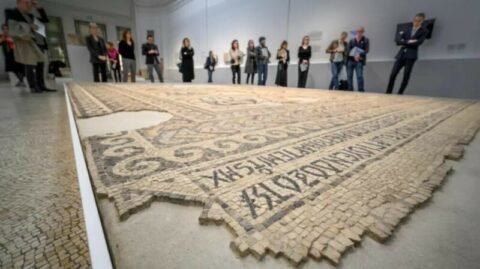The Jersey Museum and Art Gallery
The Jersey Museum and Art Gallery has welcomed a new permanent exhibition, depicting the history of the island in a new, unique, and engaging way. The new exhibition, designed by Nissen Richards Studio in collaboration with client Jersey Heritage, aims to inspire future generations of locals and visitors alike, taking them on a journey through the island’s past, running from the Ice Age, right up to the present day.
The new exhibition has a carefully thought out thematic structure and features a group of stories arranged as ‘narrative islands’. Named ‘La Tèrr’rie d’Jèrri – d’s histouaithes dé not’ Île / Being Jersey – Stories of our Island’, the exhibition considers the island of Jersey through perspectives that are both literal and metaphorical, relating to the island as ‘sacred’, ‘exotic’ or ‘contested’. Although separate, these narrative islands come together to tell the story of the uniqueness of Jersey.
The 485 sq. m. exhibition is a major move for the Museum and its client Jersey Heritage and involved the complete transformation of the previous permanent exhibition, with the clear directive to undertake a totally new approach.
The exhibition title is given in English and Jèrriais, the traditional language of the Jersey people. Although the use of this historic, Norman Romance language is in decline, the Museum is one of the institutions actively seeking to preserve the language through its role as keeper and protector of the island’s heritage.
The Jersey Museum is located in Jersey’s capital city, St Helier, in the old part of town, overlooking the harbour and seascape, set amongst a number of other historic buildings. The current building is made up of three storeys, with the ground floor dedicated to visitor arrival, along with a café and shop. The new permanent exhibition takes up the whole of the first floor, whilst a second floor, not part of the redesign, is dedicated to temporary exhibitions.
Nissen Richards Studio won the commission to redesign the permanent exhibition in summer 2023. The project brief stated that the existing exhibition had become outdated, and that its new iteration needed to be more flexible whilst remaining extensive in scope and timeline. The objects in the permanent collection also needed to be celebrated more, with the narrative brought more to the forefront.
“Our design approach took inspiration from Jersey’s unique landscape”, Pippa Nissen, Director of Nissen Richards Studio, commented. “The beach and seascape are so dominant wherever you are in Jersey and the physical nature of the island is so strong. Colours and textures are very particular, from the sunset to the beach and water. We explored this, researching new materials we’d never used before and prototyping them to ensure they evoked a real feeling of the island.”
This research and exploration process led to the creation of a specific ‘Jersey palette’ for the scheme, with more tonal, earthy colours in the main space and, later, a more intense palette used to represent a shift in mood as the subject matter darkens. In terms of materiality, the palette was made up of design ideas directly informed by the marks, traces, grooves and layers of the island’s archaeology, whilst also considering the expanse of the island and ideas relating to drama, light and colour taken from the sea, sky and horizon lines. The concept of tide and time influenced ideas about layering and the leaving behind of transient and permanent marks.
When it came to the exhibition content, the big question was whether to organise thematically or chronologically – and how to structure the pacing. The final answer was a mixture of both, examining the nature and history of the island through six thematic viewpoints. The exhibition is broken down into six ‘island’ spaces, with a central object case in each allowing for stories to unfold around it in a cluster.
Although the narrative islands are individual story groups that can be enjoyed on their own and in any order, they are of course located next to other story groups, which made the order and interrelation important, in order to feel natural to the visitors choosing to access the ‘islands’ sequentially.
The design team sought to make the retained architectural features feel cohesive within the exhibition environment and as objects in themselves. This was achieved through a high-level lighting detail that creates a wash of light across the wall, drawing attention to its texture and markings. The door surrounds and concrete additions to the historic wall were also painted to ensure they felt integrated into the space.
The project’s excellent finish is a result of Nissen Richards Studio’s knowledge, professionalism and meticulous attention to detail, and it has effectively helped to future-proof the exhibition, though the creation of a flexible design with room to grow and develop in years to come.







